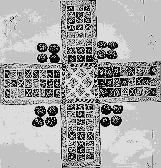People in India brought the idea of thowing the knucklebones of sheep or pigs to tell the future, or to play a game of skill like jacks, when they first came from Africa to India about 40,000 BC. But people in India may have been the first to get the idea of carving those knucklebones and turning them into marked dice. The earliest known dice in the world come from a backgammon set from Iran, from about 3000 BC. Harappan people certainly used dice about 2500 BC, and the Rig Veda and the Mahabharata both tell stories about dice.
Certainly Indian people invented a lot of board games, and they liked to play them. By the 300’s AD, people in India were playing Pachisi (we know it as Parcheesi). They made the boards out of cotton cloth, and threw six cowrie shells to determine the moves. The pieces were made of wood.
About 600 AD, people in India began to play chess. They may have gotten the idea partly from China, where versions of chess were a variation on earlier games of Go. Chess soon spread from India to the Islamic Empire and from there to Europe.

Sometime around the 1200’s AD (or possibly earlier), people in India also began playing a game they called Snakes and Ladders (we know it as Chutes and Ladders). This was a Hindu game. Each space was called a house, and each house represented a kind of emotion. You threw dice to see how far you should go, and used a cowrie shell for your piece. The ladders stood for good feelings, while the snakes stood for bad feelings that took you farther away from Nirvana.
People in India also played the game of mancala, which probably started as an African game. Athletic games were also popular in ancient India. Wrestling matches, as in West Asia, were very common. Camel racing and boat races were also common.


